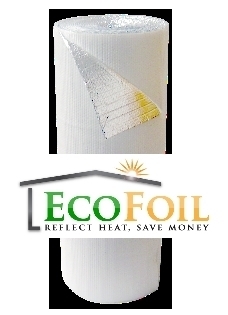EXCLUSIVE FORUM FOR MACHINE DISMANTLERS AND REPAIR PEOPLE > Gary Indiana
> Heavy Machinery
> Electrical
> High Frequency Converters
> Under 1 MhZ
> Ecofoil white/foil bubble insulation 4'X75' (300SF)
Ecofoil white/foil bubble insulation 4'X75' (300SF)
EcoFoil Radiant Barrier, Reflective Foil & Bubble Insulation
* 8 mils thick Polyethylene bubbles
* Class A/Class 1 fire rating
* White Poly side provides finished look
Product Details Double Bubble (White/Foil) Reflective Insulation is reflective bubble insulation consisting of an 8 mil double layer of polyethylene bubbles sandwiched between one sheet of highly reflective, 99% aluminum and one sheet of white polyethylene.
The white poly surface is water resistant and is very easy to keep clean. The smooth white side also provides a nice finished appearance to the interior of your building. The double bubble center provides maximum R-Value as well as creating a vapor barrier which eliminates condensation. The reflective foil side reflects 97% of radiant heat.
Size: 4' x 75' Roll (300 sq. ft.) White/Double Bubble/Foil Insulation
Double Bubble White/Foil Specs.
Flame Spread (ASTM E84-94) 97a
Smoke Development (ASTM E84-94) 97a
Water Vapor Permeance-ASTM E96
Tensile and Elongation-ASTM D882
Resistant to Fungi and Bacteria
Uses:A Radiant Barrier is an insulation system that utilizes a reflective foil insulation to BLOCK radiant heat energy opposed to conventional mass insulations that work by absorbing heat energy. In order to fully understand how radiant barriers work and how reflective insulation can benefit you, the following information has been provided for your knowledge. How Heat is TransferredTo best understand how a radiant barrier works we must first understand the different ways that heat is transferred.There are three ways in which heat is transferred from warm spaces to cold spaces:Conductive: the transfer of heat flowing through a solid or fluid material.Convective: the transfer of heat which involves the physical movement of air when it is warmed Radiant: the movement of invisible heat rays from a warm surface to a cooler surface through an air space Heat Gain and Heat LossUp to 75% of upward heat loss (through roof) is in the form of RADIANT heat.Up to 80% of sideways heat loss (through walls) is in the form of RADIANT heat.Up to 90% of downward heat gain (entering through roof) is in the form of RADIANT heat. Do I need a perforated or solid radiant barrier?In certain applications a radiant barrier MUST be perforated to allow water vapor to pass through it. For example, when used on the attic floor the perforated radiant barrier must be used. This is necessary because during the cooler months, if there is no effective vapor retarder at the ceiling, water vapor from the living space may condense (and even freeze) on the underside of a radiant barrier lying on the attic floor and cause water damage to the ceiling and any existing attic floor insulation.
How does Radiant Barrier work in the summer and the winter?A Radiant Barrier works by reflecting radiated heat rays back towards the source they originated from. To help understand how why it works in both climates we have explained each situation below.SummerDuring the summer, the main source of wasted energy in your home is cause by the heat gain when the roof and walls absorb radiant heat from the sun. This heat is then conducted toward the attic space and eventually radiated into the attic. Most of this radiated heat can be reflected back towards the outside when a Radiant Barrier is installed. Without a Radiant Barrier the heat will be collected by the attic space and interior of the home. Fiberglass insulation does very little to stop Radiated Heat. In addition, The Air Conditioner and Ductwork also absorb attic heat, which is then blown into the house. A properly installed Radiant Barrier blocks 97% of this radiant heat which will save money on cooling the home.
WinterDuring the winter, the main source of wasted energy in your home is caused by heat that is lost by your home when it naturally rises from inside the home and escapes through the ceiling into the attic and then out through the roof. Heat is radiated in all directions through the ceiling, walls and floor. Obviously the more heating energy that is lost, the more heating energy it takes to replace it. A Radiant Barrier reduces this wasted energy by reflecting most of the rising heat back towards the interior of the building.
* EcoFoil cannot guarantee any delivery times. Once a package leaves our warehouse we have no control over unforeseen delays.
If you have any more questions feel free to call us at...

